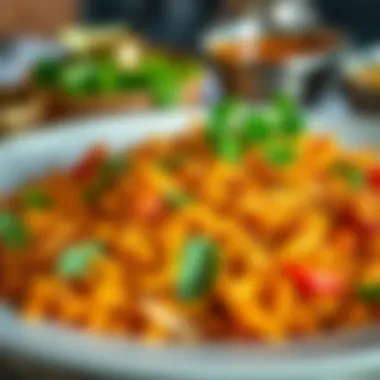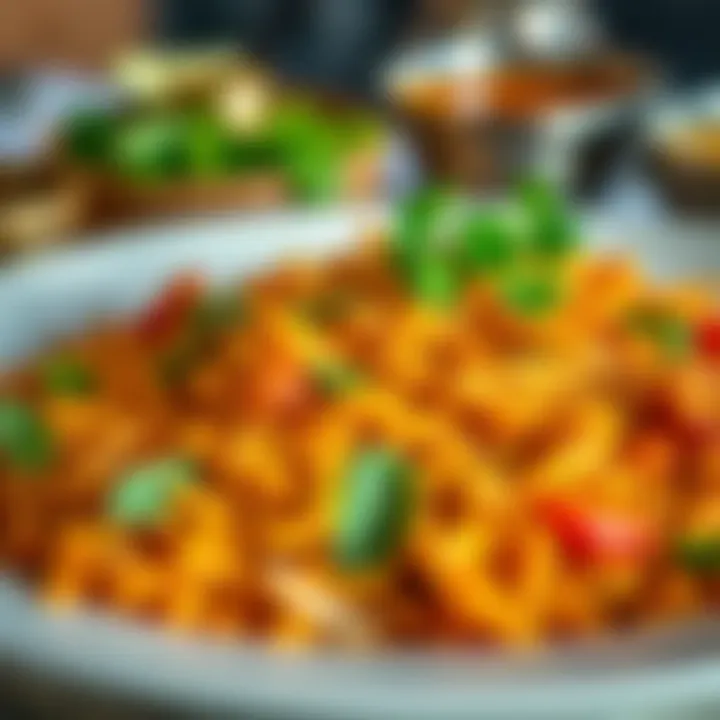Discovering Authentic Indian Cuisine in Dubai


Intro
As the sun dips low on the horizon, casting a warm glow over the bustling streets of Dubai, one can’t help but feel the drumbeat of culinary diversity. Among the rich medley of cuisines, Indian gastronomy stands out like a vibrant tapestry, woven with stories of tradition and innovation. From the spicy aromas wafting through the air to the intricate flavors that dance on the palate, the Indian dining experience in Dubai offers an adventurous journey for gastronomes.
Dubai, a melting pot of cultures, plays host to a plethora of Indian restaurants. Each establishment captures the essence of India's diverse culinary heritage, making it the perfect setting for food enthusiasts eager to immerse themselves in the flavors of this remarkable cuisine. Much more than mere places to eat, these restaurants serve as cultural hubs where stories and flavors intertwine; a celebration of heritage nestled in this cosmopolitan gem of the Middle East.
In this guide, we will take a closer look at various Indian culinary destinations throughout Dubai, exploring their unique offerings that keep diners coming back for more. With a dash of tradition and a sprinkle of modern flair, this exploration is bound to appeal to those with discerning tastes and curious palates.
We will delve into the historical context behind some famed dishes, examining how the cultural significance influences dining experiences across the city. From fragrant biryanis echoing celebrations of old to the rich curries that comfort the soul, Dubai's Indian dining scene is a vibrant yet comforting embrace of flavors. Prepare yourself for a mouth-watering journey through an ever-evolving landscape that pays homage to authenticity while carving out a niche in contemporary cuisine.
Preface to Indian Cuisine in Dubai
Indian cuisine holds a prominent place within the melting pot of Dubai’s culinary offerings. The significance lies in its rich flavors and diverse ingredients that appeal to a vast audience, including both locals and expatriates. Exploring this culinary landscape not only showcases the variety of food available but also uncovers layers of history that have contributed to its current form.
The role of Indian cuisine in Dubai is multifaceted. For one, it serves as a bridge connecting various cultures, allowing individuals from different backgrounds to share in the experience of enjoying authentic Indian dishes. As diners immerse themselves in the bold spices and intricate flavors, they often become part of a larger narrative that reflects the city’s diverse demographic.
Moreover, the adaptation of Indian food in the UAE has led to the emergence of innovative dishes that combine traditional methods with contemporary techniques. This evolution highlights how Indian gastronomy in Dubai isn't just a replication of culinary traditions; it’s a dynamic interplay where local ingredients and culinary influences create something novel yet rooted in authenticity.
In addition, the strong community of Indian expatriates in the city has solidified the demand for authentic Indian dining experiences. Restaurants that capture the essence of home cooking often find themselves thriving amidst an array of offerings.
Historical Context of Indian Food in Dubai
To understand the present state of Indian cuisine in Dubai, it’s essential to peel back the layers of history that have allowed it to flourish. The arrival of Indian traders in the Gulf region dates back centuries. As these traders settled into Dubai, they brought not only their goods but also their culinary traditions. The silk route indirectly opened doors to cultural exchange, enabling Dubai to gradually embrace a variety of Indian flavors.
With the economic boom in the UAE during the 20th century, Dubai became a hotspot for Indian immigration. Thousands of people relocated for work opportunities, thereby enriching the local gastronomy with their culinary heritage. Traditional Indian dishes like biryani and curry were made available alongside the introduction of regional specialities.
Today, the intertwining of traditional and modern aspects of Indian gastronomy is evident in Dubai’s restaurant scene. Old family recipes continue to be cherished while new creations capture the essence of Indian cuisine, ensuring that culture remains alive through food.
The Influence of Indian Culture on Dubai's Culinary Scene
The influence of Indian culture on the culinary landscape of Dubai cannot be overstated. Cultural practices, festivals, and daily rituals often revolve around food, and Indian communities have brought their unique culinary traditions to the forefront. Great feasts during festivals like Diwali and Eid showcase a wealth of culinary expertise, inviting not just Indian nationals but also people from various backgrounds to participate.
Additionally, the flavors of Indian street food have found their way into local eateries and markets, offering dining options that resonate with both nostalgia and innovation. Dishes such as pav bhaji and vada pav have managed to carve out a special place on Dubai’s food maps, appealing to adventurous palates eager to try something new.
Recognizing the importance of Indian gastronomy within the larger context of Dubai's culinary scene is crucial, as it adds to the cultural richness and diversity that the city represents. As culinary enthusiasts seek out authentic Indian flavors, they also engage with a cultural tapestry that celebrates tradition while embracing change.
"In Dubai, every plate tells a story, rich with heritage and tradition, bringing communities together through a shared love for food."
This explains why a thorough exploration of Indian gastronomy in Dubai is not just about food—it reflects the city's identity and its journey through time.
Understanding Regional Variations in Indian Cuisine
Indian cuisine is not just food; it’s a journey through regions, cultures, and traditions. In Dubai, where the melting pot of cultures thrives, understanding these regional variations becomes crucial. Each dish tells a story of its origin, shaped by geographic and cultural nuances. This variety not only offers culinary enthusiasts diverse flavors but also reflects the rich heritage of India. By exploring these variations, one gains insight into the identities and histories of the communities represented in Dubai's food scene. It’s a gateway to appreciating not just what’s on the plate, but the multifaceted tapestry of Indian culture.
North Indian Specialties
Paneer Dishes
The hallmark of North Indian cuisine lies in its paneer dishes. Whether it's paneer butter masala or palak paneer, the texture and richness of paneer stands out. This dairy product is not only versatile but also a crowd-pleaser, making it a must-try for many diners. The dense chunks of cottage cheese absorb spices beautifully, resulting in a dish that appeals to both vegetarians and carnivores alike. It's a popular choice especially for its creamy taste and nutritional value. Paneer serves as a familiar comfort for many diners in Dubai, bridging gaps across different palates. However, one could argue that its creamy nature might not be for everyone, pushing some towards lighter options.
Tandoori Variants
Tandoori food is the soul of Indian barbecuing. Dishes cooked in a tandoor—whether it’s chicken, fish, or even vegetables—are characterized by their smoky flavor and vibrant reddish hue. The marination of proteins in a blend of yogurt and spices infuses not just taste but also tenderness. Tandoori dishes are often celebrated for their health-conscious appeal, offering grilled options without compromising on flavors. The uniqueness of this cooking method enhances the experience, making it a popular choice for casual dining in Dubai. However, some diners might find certain tandoori dishes a bit too charred for their liking.
Rich Curries
Rich curries complete the North Indian experience. These dishes are typically luxurious in texture and flavor, incorporating a symphony of spices and aromatics. Common ingredients like cream, nuts, and even yogurt create a velvety smoothness that leaves a lasting impression. Curries such as butter chicken or rogan josh are deeply seasoned and perfect for pairing with naan or rice. They contribute gravitas to any meal, showcasing Indian culinary prowess. On the downside, the rich nature of these curries may not sit well with those aiming to keep their meals lighter and healthier.


South Indian Delights
Dosas and Idlis
Dosas and idlis represent the quintessential breakfast fare from South India. Dosas, thin and crispy, are often made from fermented rice and lentil batter, while idlis are soft, steamed cakes that serve as a perfect canvas for chutney and sambar. Their popularity lies in how they cater to varying tastes; they are light, flavorful, and pack a punch when paired with aromatic dips. As breakfast staples, they are not only nutritious but also versatile. Yet, some may find the concept of fermented dishes unusual, which could deter potential diners who prefer a milder experience.
Spicy Chettinad Curries
Chettinad cuisine is notoriously known for its heat and complex flavors. Originating from Tamil Nadu, these spicy curries—often featuring chicken, lamb, or seafood—are brimming with aromatic spices like star anise and fennel seeds. Their intense flavors capture the essence of Southern cooking. Many food enthusiasts delight in the authentic spice level, elevating the regional experience. However, not everyone appreciates such heat, and the uninitiated might need to tread cautiously when diving into these dishes.
Coconut-based Dishes
Coconut serves as a vital ingredient in many dishes from South India. Whether in the form of coconut milk, grated fresh coconut, or oil, it adds a creamy texture and a hint of sweetness. Dishes like coconut curry often reflect the coastal influence of this region, appealing to seafood enthusiasts. This ingredient not only enriches flavor but also provides health benefits, making dishes more wholesome. On the flip side, those who dislike coconut might find these dishes less appealing, limiting their options.
Western and Eastern Indian Flavors
Seafood from Bengal
When it comes to seafood, few regions can match the finesse of Bengali cuisine. Known for dishes like macher jhol (fish curry) and chingri malai curry (prawn in coconut milk), the freshness of the catch combined with regional spices creates a unique culinary experience. Deservedly, Bengali seafood showcases both expertise and respect for local ingredients. With its delicate flavors and emphasis on freshness, it appeals greatly to seafood aficionados. Nonetheless, availability might be a concern in Dubai, with authentic ingredients sometimes hard to source.
Gujarati Thali
The Gujarati thali is a celebration of color and flavor, offering a variety of vegetarian dishes served on a single platter. From the sweet-sour chutneys to the savory dals and vegetables, this communal dining experience encourages sharing and variety. Rich in nutrients and designed to provide a complete meal, it caters well to those looking for healthy options. However, the unique blend of flavors may be an acquired taste for some diners not accustomed to the sweetness prevalent in Gujarati dishes.
Street Food Influences
Street food serves as the heart and soul of any Indian city, and Dubai is no different. From pani puri to vada pav, each dish tells the story of a vibrant culinary tradition. Enjoying street food allows diners to experience quick bites that pack a flavorful punch, often on-the-go. This informal dining is popular among locals and tourists alike, giving all a taste of Indian culture. While there’s risk involved—such as hygiene concerns—its convenience and flavorsome nature keep food lovers returning for more.
Top Indian Restaurants to Consider
When it comes to savoring authentic Indian gastronomy, the dining experience is just as critical as the food itself. Dubai's culinary landscape boasts a wealth of Indian restaurants that cater to a diverse audience. Each establishment brings its unique flavor, atmosphere, and cultural significance. This section delves into the various dining options available, emphasizing the elements that contribute to their popularity and overall dining experience.
Fine Dining Experiences
In the realm of Indian cuisine, fine dining spots often walk the fine line between artistry and culinary tradition. These restaurants curate an experience that transcends mere eating, transforming it into a celebration of Indian flavors, culture, and elegance.
Ambience and Decor
The ambience and decor of a fine dining restaurant set the stage for an unforgettable experience. Elegant interiors often highlight intricate Indian patterns, traditional fabrics, and warm lighting that aim to evoke the essence of India. This characteristic makes such places popular among those who seek an immersive atmosphere. One outstanding feature is the enchanting use of lanterns or chandeliers that create a comfortable yet sophisticated vibe. However, while some might find this level of elegance appealing, it could deter casual diners looking for a more relaxed setting.
Signature Dishes
Signature dishes are the heart and soul of any fine dining menu. They often showcase the chef's skill and the authenticity of Indian cuisine. Many establishments offer classics like Biryani, sometimes with a modern twist. The rich flavors and beautifully plated food underscore why these dishes are popular among food aficionados. They're not just meals; they are representations of a culinary journey. Nevertheless, the inventive creations might surprise those who expect strictly traditional offerings, adding a unique flavor to their experience.
Wine Pairings
Wine pairings in Indian dining establishments reflect a growing trend toward enhancing the meal's overall flavor profile. Thoughtful pairings between Indian spices and specific wines can elevate the dining experience significantly. Restaurants often highlight local or international wines that complement spicy or rich flavors. This approach opens up new avenues for culinary exploration but might confuse diners who are unfamiliar with the intricate relationship between wine and Indian food. It demonstrates the restaurant's commitment to providing a comprehensive dining experience.
Casual Dining Options
Casual dining options offer more relaxed environments that are family-friendly and affordable. This setting allows diners to engage with authentic Indian cuisine without breaking the bank, all while enjoying the warmth of Indian hospitality.
Family-Friendly Environments
Family-friendly environments within Indian restaurants create spaces where everyone feels welcome. Large tables and vibrant decorations often characterize these venues, making them suitable for gatherings. Kid-friendly menus or play areas are typically a hallmark, ensuring children enjoy their time as much as their parents do. This feature is tremendously beneficial for families looking to explore Indian flavors without worrying about their kids' dining preferences. However, larger crowds can sometimes lead to noise and wait times, which could be a downside for those seeking a quieter experience.
Traditional Thali Meals


Traditional thali meals offer a platter of various dishes, showcasing different flavors and textures of Indian cuisine. This approach is not only a feast for the stomach but also a feast for the eyes. The combination of curries, breads, and sides on one plate makes it a robust choice for many diners. With thali meals, diners can experience a wide variety of tastes in one sitting, making it popular for those wanting to sample numerous dishes. The only potential drawback is the portion size; if one isn't careful, overindulgence can occur.
Budget-Friendly Picks
For those mindful of their wallets, budget-friendly picks still offer an opportunity to enjoy authentic Indian food without compromising quality. Street-style foods, lesser-known curries, or daily specials can lead to an impressive meal without making one feel guilty. Value for money and abundant portion sizes are key characteristics of such establishments, making them a smart yet delicious choice. The only limitation might be the lack of elaborate decor and service, which some diners may prefer in a dining experience.
Street Food and Takeaway
For many, street food evokes a sense of nostalgia and authenticity. The casual, vibrant settings combined with the rich flavors of Indian street food present a unique dining aspect.
Popular Street Food Snacks
Indian street food snacks are an exploration in flavor and texture, ranging from Pani Puri to Vada Pav. The preparation methods and ingredients often symbolize regional diversity, lending character to each bite. These snacks boast a delightful mix of spices, fresh ingredients, and of course, a pinch of love. Their convenience makes these options appealing for a quick bite. However, those unaccustomed to street food might find it a gamble, as hygiene can vary from vendor to vendor.
Takeaway Convenience
Takeaway options have become increasingly significant in Dubai's vibrant culinary landscape. Found at numerous eateries, the convenience of easily transporting food makes it simpler for those who want to enjoy Indian flavors at home. Many restaurants offer dedicated takeaway menus, ensuring the food retains its quality during transit. This feature is especially beneficial for busy professionals or families looking to enjoy a meal without dining out. Yet, the takeaway experience might lose some of that fine dining magic one experiences while enjoying dishes in a well-curated environment.
Hidden Gems
Dubai is home to a host of hidden gems offering authentic Indian cuisine. These smaller, often family-run restaurants serve dishes made with age-old recipes and a deep understanding of flavor. Exploring these places can uncover unique culinary experiences that big-name restaurants might miss. The charm of these venues often lies in their low-key approach, allowing for an intimate dining experience. However, limited advertising or visibility can mean these spots remain undiscovered by the broader public, which could be a disadvantage in today's competitive food scene.
"Finding that unassuming eatery tucked away from the bustling streets often leads to the most memorable food experiences."
Authenticity and Ingredient Sourcing
In the heart of Dubai, the essence of Indian cuisine cannot be fully captured without considering the vital roles of authenticity and ingredient sourcing. This aspect is crucial, not just for the culinary purity of the dishes served, but also for the respect it shows to the rich heritage that Indian gastronomy embodies. Authenticity goes beyond using traditional recipes; it encompasses the careful selection of ingredients that honor the diverse regions of India. When it comes to Indian cuisine in Dubai, understanding ingredient sourcing helps to highlight cultural narratives that mesh seamlessly with the vibrant gastronomic experiences presented in the restaurants across the city.
The Importance of Authentic Ingredients
A dish can be as intricate as a tapestry, woven with flavors that tell a story; however, if the threads are not genuine, the narrative falls flat. Authentic ingredients play a key role in crafting dishes that resonate with the true flavors of India. For instance, the difference between using real saffron from Kashmir and synthetic saffron can significantly alter a dish's taste and aroma. Moreover, authentic ingredients often carry specific certifications or geographical indications that add to their value.
- Flavor Depth: Authentic ingredients provide a complexity of flavors that is often lost with substitutes.
- Cultural Respect: Using genuine ingredients connects chefs and diners with the traditions and histories of India’s diverse regions.
- Health Factors: Non-authentic or mass-produced ingredients can sometimes contain preservatives or chemicals, while traditional ingredients tend to be more wholesome.
When seeking an authentic culinary experience in Dubai, one should pay close attention to the sources of spices, herbs, and other ingredients. As the saying goes, "you can't make a silk purse out of a sow's ear." In culinary terms, this means that the end result can never exceed the quality of its underlying ingredients.
Local vs. Imported Produce
When considering ingredient sourcing in Dubai's Indian restaurants, a critical discussion arises about the prevalent dichotomy between local and imported produce. On one hand, local produce is often fresher and better suited to the climatic conditions of the region. On the other, certain ingredients—especially spices and specific vegetables—are best sourced from their regions of origin for authenticity.
- Local Produce Advantages:
- Imported Produce Necessity:
- Freshness, leading to better flavor and nutritional value.
- Support for local farmers, which helps sustain the economy.
- Less carbon footprint due to reduced transportation.
- Ingredients like Kashmiri chilies or Hyderabadi biryani masalas are pivotal in authentic dishes, and sourcing them from India ensures culinary fidelity.
- Expertise and specificity in flavor profiles that local substitutes may lack.
In the grand tapestry of Dubai's Indian culinary scene, both local and imported ingredients have their roles. Ideally, a blend of both yields the best results, creating dishes that are not only flavorful but also steeped in the cultural narratives they represent. Thus, the discussion of authenticity and ingredient sourcing is not just a culinary pursuit; it is a window into the larger cultural and economic exchanges occurring within the fabric of Dubai.
"Good food is a pillar of happiness, and the right ingredients are its foundation"
In light of these discussions, discerning diners have the opportunity to appreciate the thoughtfulness behind the ingredients, adding layers to their dining experience that transcend mere taste.
Cultural Elements Influencing Indian Dining
The intersection of various cultures manifests itself profoundly in culinary practices, and Indian food is no exception. Dining is much more than just a meal; it is woven with layers of cultural significance that resonate throughout communities. In a place like Dubai, where a melting pot of nationalities thrives, this essence is particularly palpable. From shared meals during festive occasions to the observance of age-old religious traditions, understanding these cultural elements provides valuable insight into the broader context of Indian gastronomy in Dubai.
Celebratory Feasts and Festivals


Indian festivals are synonymous with vibrant colors, intricate rituals, and, importantly, food. Celebratory feasts hold much significance, acting as a culinary canvas that showcases regional specialties and communal spirit. During Diwali, for instance, the tables overflow with sweets like gulab jamun and samosas, symbolizing prosperity and joy. In contrast, during Eid, biryani and kebabs take center stage, representing unity and gratitude.
Families gather, often sharing large plates of food, emphasizing a sense of belonging that is crucial in the fast-paced urban setting of Dubai. For many Indian expatriates, these meals serve as a portal to their homeland, bringing back cherished memories while maintaining their cultural identity amidst the hustle and bustle of a foreign land.
- Community Involvement: Celebrations often see the participation of neighbors and friends who are invited to share in the feast. This open-door policy cultivates relationships beyond just food.
- Diverse Flavors: Each festival brings unique dishes tied to the region, showcasing the culinary diversity present in Indian cuisine.
"Food has a way of bringing us together, it transcends borders and speaks a universal language."
Religious Significance of Food
Food in Indian culture intertwines deeply with spiritual beliefs and practices. Each meal can often reflect religious teachings or local customs, with certain ingredients deemed sacred or forbidden. For instance, many Hindus refrain from eating beef, considering the cow a holy animal, while Muslims avoid pork altogether, aligning their diets with Islamic tenets.
Moreover, key rituals such as puja (worship) often incorporate offerings of food to deities, reflecting a gratitude that Siddharta Gautama described as a necessary aspect of spiritual well-being. Post-prayer, these offerings are shared among families, reinforcing communal bonds.
- Dietary Restrictions: Understanding these restrictions provides investors in the food sector a clearer picture of the market landscape. Catering to these dietary preferences can set businesses apart.
- Celebratory Dishes: Many dishes are made to honor religious festivals, like kheer during Raksha Bandhan, representing familial love and strength.
The essence of food in Indian culture goes well beyond taste; it embodies collective identities, values, and histories that have been shaped over centuries. For those navigating the dining scene in Dubai, recognizing these cultural elements enhances not only the dining experience but also the potential for business opportunities within this rich tapestry.
For more on the cultural aspects of Indian cuisine, consider checking out Britannica and Wikipedia.
In summary, understanding these cultural elements is paramount for anyone looking to engage with Indian gastronomy in Dubai—whether for culinary enthusiasts, potential investors, or even families eager to recreate their homeland’s flavors in their new city.
The Role of Technology in Modern Indian Dining
In the ever-evolving landscape of dining, technology has etched its mark, transforming how cuisine is enjoyed and accessed. For Indian gastronomy, particularly in a melting pot like Dubai, the integration of technology is not merely about convenience; it's about enhancing the entire experience. From online reservations to home delivery services, each facet works in concert to ensure that Indian cuisine remains accessible and appealing to both locals and tourists alike.
Online Reservations and Reviews
Gone are the days when one had to call a restaurant to secure a table. Now, online reservation systems have become the norm. Platforms like OpenTable and Bookatable enable diners to book their favorite Indian restaurants with a few clicks. This seamless process benefits both consumers and restaurateurs. For diners, it reduces wait times and provides an assurance of a table during peak hours. For restaurants, managing reservations is streamlined, minimizing no-shows and maximizing dining capacity.
Reviews play a pivotal role in this digital framework. A glowing testimonial on Google or Zomato can draw crowds, while a critical review can spell disaster. Potential diners often scroll through customer feedback, looking for critiques that resonate with their own preferences. In this sense, restaurants serving Indian cuisine in Dubai are not only competing with each other, but they are also striving to create authentic experiences that translate into positive feedback. Moreover, social media platforms like Instagram amplify this dynamic, showcasing dishes through appealing visuals and attracting new patrons.
"In a city where culinary choices abound, a simple review could change the fate of a restaurant."
Home Delivery Services
The rise of food delivery platforms such as Deliveroo, Talabat, and Zomato has reshaped the way people indulge in Indian cuisine. The convenience of having a piping hot biryani or a fragrant curry delivered to one’s doorstep is hard to resist. This shift not only caters to the busy lifestyles of urban dwellers but also presents an opportunity for Indian restaurants to expand their customer base beyond the confines of their physical locations.
Home delivery services offer various benefits:
- Varied Choices: Diners can explore dishes from different Indian regions without stepping outside.
- Custom Orders: Many platforms allow customization, enabling customers to tweak their orders according to dietary preferences or spice levels.
- Packaging Innovations: Restaurants invest in quality packaging to ensure the food's integrity during transport. Keeping the aroma and texture intact is key to delivering a satisfying meal.
While the convenience is unquestionable, there are considerations to keep in mind. Restaurants must adapt their menu items for delivery without compromising quality or presentation, which can be a task in itself. Coordinating with delivery services also demands efficient logistics and timely service—every delay can turn a joyous dining experience into a frustrating narrative.
The End: The Significance of Indian Cuisine in Dubai
Indian cuisine holds an exceptional place within Dubai's diverse culinary landscape. With a population rich in cultural heritage, the Indian diaspora has contributed significantly to the gastronomic scene, shaping its flavors, practices, and even social dynamics. Understanding this significance goes beyond merely tasting the dishes; it's about grasping the essence of a culture that has mingled and melded with local flavors and traditions.
Culinary Diversity as a Reflection of Culture
The plurality of Indian food in Dubai is a microcosm of its wider cultural tapestry. Each dish tells the story of its region, showcasing ingredients and techniques that have transcended geographical boundaries. For instance, while one might relish the creamy butter chicken representative of North Indian cuisine, another may gravitate towards the spicy Chettinad curries that characterize South Indian fare. This array of flavors does not merely cater to taste but reflects the essence of unity in diversity.
Diners often discover that many food choices are linked to festivals, traditions, and religious observances. Be it the Diwali feast featuring sweets like Gulab Jamun or the Onam Sadhya served on banana leaves, the culinary presentation is often an art form in its own right—each plate is a celebration of cultural identity. Such experiences invite diners to not only satisfy their palate but also immerse themselves in a rich tapestry of history and tradition.
The Future of Indian Restaurants in Dubai
Looking ahead, the future of Indian restaurants in Dubai appears promising, fueled by an appetite for innovation and authenticity. Emphasizing sustainability and modern cooking techniques, many establishments are beginning to embrace farm-to-table practices. Sourcing locally while retaining traditional methods may not only reduce carbon footprints but also promote community engagement.
Additionally, the rise of technology within the culinary realm, such as online reservations and mobile apps for food delivery, suggests a potential shift in how Indian cuisine will be experienced. Diners are increasingly seeking convenience without compromising on quality. As chefs experiment with fusion dishes—such as Korean tikka tacos or sushi with a curry twist—the landscape will continue to evolve, reflecting a balance of tradition and modernity.
Indian cuisine in Dubai isn't just about food; it's a cultural phenomenon with layered meanings and significance. It serves as a reminder of the ties that bind communities, fostering an understanding that goes beyond taste. Those who choose to explore Indian gastronomy in Dubai not only embark on a culinary journey but also become part of a larger dialogue about culture, identity, and the very act of dining together.
"Food is a universal language; it can bridge gaps and foster connections that words may often fail to express."
As the Indian gastronomic scene develops and diversifies, investors and culinary enthusiasts alike should keep a keen eye on these evolving trends that promise to add depth to the culinary offerings of this vibrant city. The future appears to hold exciting prospects for those willing to embrace the unique flavors and cultural narratives that Indian cuisine brings to Dubai.











